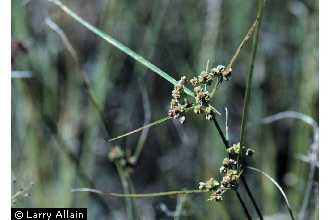Cyperus pseudovegetus
Common Names: Marsh Flatsedge; Green Flatsedge [1]
| Cyperus pseudovegetus | |
|---|---|

| |
| Photo from USDA NRCS Plants Database. | |
| Scientific classification | |
| Kingdom: | Plantae |
| Division: | Magnoliophyta - Flowering plants |
| Class: | Liliopsida - Moncots |
| Order: | Cyperales |
| Family: | Cyperaceae |
| Genus: | Cyperus |
| Species: | C. pseudovegetus |
| Binomial name | |
| Cyperus pseudovegetus Steud. | |

| |
| Natural range of Cyperus pseudovegetus from USDA NRCS Plants Database. | |
Contents
Taxonomic Notes
Synonyms: C. virens Michaux
Variety: none
Description
C. pseudovegetus is a perennial praminoid of the Cyperaceae family native to North America. [1]
Distribution
C. pseudovegetus is native to the eastern United States, including New Jersey and Massachusetts, west to southern Illinois and south Missouri, south to Florida, and west to Texas and Oklahoma.[2]
Ecology
Habitat
Common habitats for the C. pseudovegetus include marshes, ditches, and other depressions with moist soils, for instance samples have been taken from pine flatwoods, edges of ponds and rivers, and other depressions that consist of moist soils.[2][3] It is also listed as a facultative wetland species, where it commonly occurs in wetlands, but can occasionally be found in non-wetland habitats.[1] This species commonly prefers wet, open habitats with full sun.[4]
Associated species: Taxodium sp., Quercus sp., Nyssa' sp., Magnolia sp., Acer rubrum, Liquidambar styraciflua, Cyperus strigosus, C. surinamensis, Carex sp., Juncus sp., Hyptis alata, Rudbeckia mohrii, and Eleocharis obtusa.[3]
Phenology
It is known to flower from July to October.[2] This flowering period is also when fruit is developed.[4]
Use by animals
C. pseudovegetus attracts birds, and is highly deer resistant.[4]
Conservation and Management
It is listed as rare by the Indiana Department of Natural Resources, and as endangered by the New Jersey Department of Environmental Protection and Energy.[1]
Cultivation and restoration
Photo Gallery
References and notes
- ↑ 1.0 1.1 1.2 1.3 USDA Plant Database Cite error: Invalid
<ref>tag; name "USDA" defined multiple times with different content - ↑ 2.0 2.1 2.2 Weakley, A. S. (2015). Flora of the Southern and Mid-Atlantic States. Chapel Hill, NC, University of North Carolina Herbarium.
- ↑ 3.0 3.1 URL: http://herbarium.bio.fsu.edu. Last accessed: June 2018. Collectors: Loran C. Anderson, K. Craddock Burks, R. K. Godfrey, R. Kral, P. REdfearn, Sydney Thompson, Culver Gidden, R. THorne, R. Davidson, R. Norris, Cecil Slaughter, William Platt, Richar Carter, SHaron Carter, W. George. States and counties: Florida (Wakulla, Liberty, Nassau, Franklin, Washington, Leon, Jefferson, Gulf, Gadsden, Holmes, Calhoun, Taylor) Georgia (Thomas, Upson, McIntosh, Lowndes, Clinch, Berrian)
- ↑ 4.0 4.1 4.2 [[1]] Lady Bird Johnson Wildflower Center. Accessed: April 25, 2019